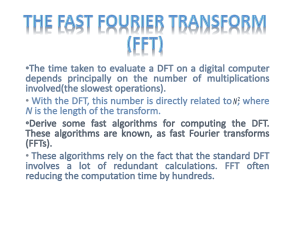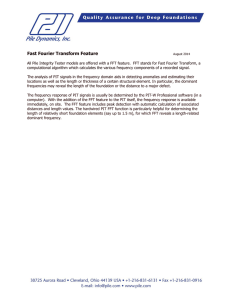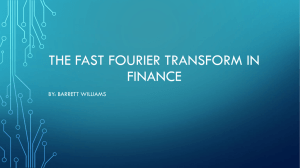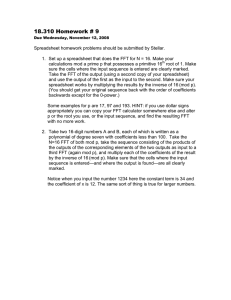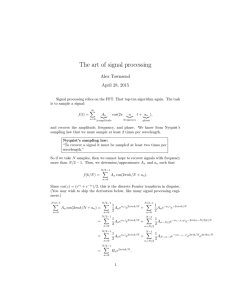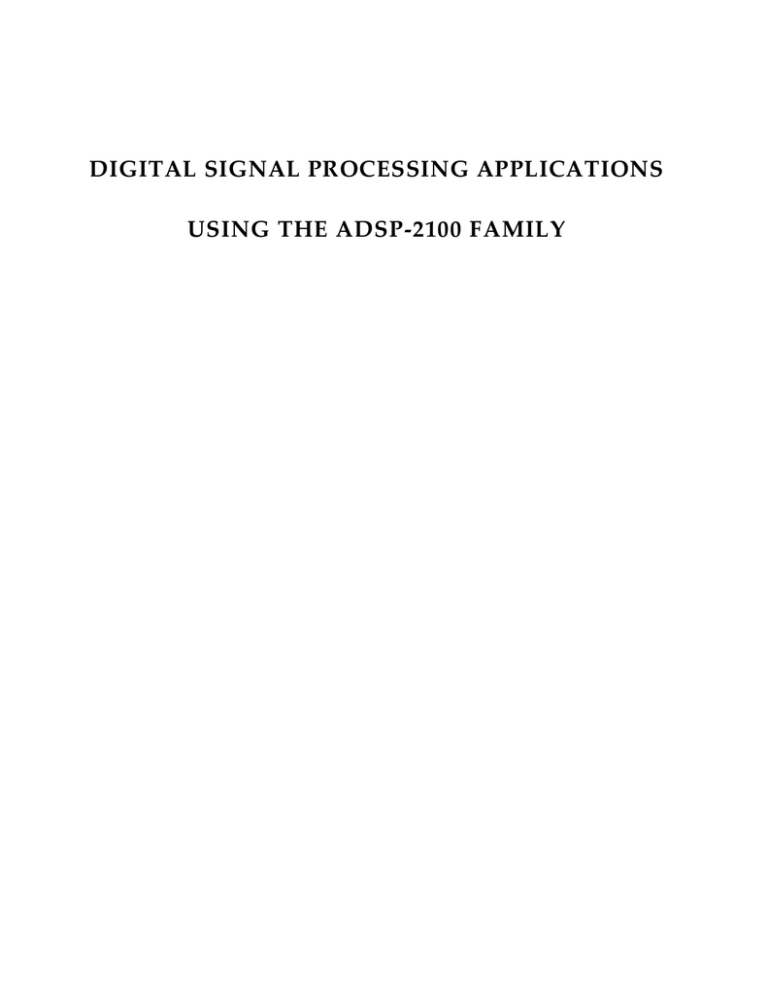
DIGITAL SIGNAL PROCESSING APPLICATIONS
USING THE ADSP-2100 FAMILY
ANALOG DEVICES TECHNICAL REFERENCE BOOKS
Published by Prentice Hall
Analog-Digital Conversion Handbook
Digital Signal Processing in VLSI
Digital Signal Processing Applications Using the ADSP-2100 Family
Published by Analog Devices
Nonlinear Circuits Handbook
Transducer Interfacing Handbook
Synchro & Resolver Conversion
DIGITAL SIGNAL PROCESSING APPLICATIONS
USING THE ADSP-2100 FAMILY
by
The Applications Engineering Staff of Analog Devices, DSP Division.
Edited by Amy Mar
PH logo here
PRENTICE HALL, Englewood Cliffs, NJ 07632
© 1990 by Analog Devices, Inc., Norwood, MA 02062
Prentice
Hall
logo here
Published by Prentice-Hall, Inc.
A Division of Simon & Schuster
Englewood Cliffs, New Jersey 07632
All rights reserved. No part of this book may be reproduced, in any form or by any means, without
permission in writing from the copyright owner.
Information furnished by Analog Devices, Inc., is believed to be accurate and reliable. However, no
responsibility is assumed by Analog Devices, Inc., for its use.
Analog Devices, Inc., makes no representation that the interconnection of its circuits as described herein
will not infringe on existing or future patent rights, nor do the descriptions contained herein imply the
granting of licenses to make, use, or sell equipment constructed in accordance therewith.
Specifications and prices are subject to change without notice.
Printed in the United States of America
10
9
8
7
6
5
4
3
2
1
ISBN
Prentice-Hall International (UK) Limited, London
Prentice-Hall of Australia Pty. Limited, Sydney
Prentice-Hall Canada Inc., Toronto
Prentice-Hall Hispanoamericana, S.A., Mexico
Prentice-Hall of India Private Limited, New Delhi
Prentice-Hall of Japan, Inc., Tokyo
Simon & Schuster Asia Pte. Ltd., Singapore
Editora Prentice-Hall do Brasil, Ltda., Rio de Janeiro
Table of Contents
Contents
Preface
Page
................................................................................v
..................................................................................
CHAPTER 1 INTRODUCTION
1.1 OVERVIEW
..................................................................................
1.2 ADSP-2100 FAMILY OF PROCESSORS..........................................1
1.2.1 ADSP-2100 Architecture...........................................................2
1.2.2 ADSP-2101 Architecture...........................................................6
1.3 ASSEMBLY LANGUAGE OVERVIEW................................................8
1.4 DEVELOPMENT SYSTEM.................................................................10
1.5 CONVENTIONS OF NOTATION........................................................11
1.6 PROGRAMS ON DISK.........................................................................12
1.7 FOR FURTHER SUPPORT..................................................................12
1
CHAPTER 2 FIXED-POINT ARITHMETIC
2.1
2.2
2.3
2.4
2.5
2.6
2.7
OVERVIEW
..................................................................................
SINGLE-PRECISION FIXED-POINT DIVISION...............................15
MULTIPRECISION FIXED-POINT ADDITION..................................18
MULTIPRECISION FIXED-POINT SUBTRACTION........................21
MULTIPRECISION FIXED-POINT MULTIPLICATION....................23
MULTIPRECISION FIXED-POINT DIVISION...................................29
REFERENCES
..............................................................................31
13
CHAPTER 3 FLOATING-POINT ARITHMETIC
3.1 OVERVIEW
..................................................................................
3.2 FIXED-POINT TO FLOATING-POINT CONVERSION....................34
3.2.1 Fixed-Point (1.15) to IEEE Floating-Point.............................35
3.2.2 Fixed-Point (1.15) to Two-Word Floating-Point...................36
3.3 FLOATING-POINT TO FIXED-POINT CONVERSION....................37
33
3.4
3.5
3.6
3.7
3.8
3.9
3.3.1 IEEE Format to Fixed-Point Format (1.15)............................37
3.3.2 Two-Word Format to Fixed-Point Format (1.15)..................41
FLOATING-POINT ADDITION.............................................................42
FLOATING-POINT SUBTRACTION...................................................43
FLOATING-POINT MULTIPLICATION...............................................45
FLOATING-POINT DIVISION..............................................................47
FLOATING-POINT MULTIPLY/ACCUMULATE...............................48
REFERENCES
..............................................................................50
CHAPTER 4 FUNCTION APPROXIMATION
4.1
4.2
4.3
4.4
4.5
4.6
4.7
OVERVIEW
..................................................................................
SINE APPROXIMATION......................................................................51
ARCTANGENT APPROXIMATION.....................................................54
SQUARE ROOT APPROXIMATION...................................................57
LOGARITHM APPROXIMATION.........................................................61
UNIFORM RANDOM NUMBER GENERATION...............................64
REFERENCES
..............................................................................66
51
CHAPTER 5 DIGITAL FILTERS
5.1 OVERVIEW
..................................................................................
5.2 FINITE IMPULSE RESPONSE (FIR) FILTERS................................67
5.2.1 Single-Precision FIR Transversal Filter................................68
5.2.2 Double-Precision FIR Transversal Filter...............................70
5.2.3 Two-Dimensional FIR Filter.....................................................72
5.3 INFINITE IMPULSE RESPONSE (IIR) FILTERS.............................75
5.3.1 Direct Form IIR Filter.................................................................75
5.3.2 Cascaded Biquad IIR Filter.....................................................77
5.4 LATTICE FILTERS ..............................................................................81
5.4.1 All-Zero Lattice Filter................................................................81
5.4.2 All-Pole Lattice Filter................................................................84
5.5 MULTIRATE FILTERS..........................................................................87
5.5.1 Decimation ..............................................................................88
5.5.1.1 Continuous-Time Sampling....................................88
5.5.1.2 Discrete-Time Sampling..........................................89
5.5.1.3 Decimation Filter Structure.....................................93
5.5.1.4 ADSP-2100 Decimation Algorithm........................95
5.5.1.5 A More Efficient Decimator......................................99
5.5.2 Decimator Hardware Configuration...................................102
5.5.3 Interpolation ...........................................................................103
5.5.3.1 Reconstruction of a Discrete-Time Signal.........104
5.5.3.2 Interpolation Filter Structure................................107
5.5.3.3 ADSP-2100 Interpolation Algorithm...................109
5.5.3.4 Interpolator Hardware Configuration.................113
5.5.4 Rational Sample Rate Changes.........................................113
5.5.4.1 L/M Change in Sample Rate...............................114
67
5.5.4.2 Implementation of Rate Change Algorithm.......115
5.5.4.3 ADSP-2100 Rational Rate Change Program...118
5.5.5 Multistage Implementations.................................................125
5.5.6 Narrow-Band Spectral Analysis..........................................133
5.6 ADAPTIVE FILTERS.................................................................................
5.6.1 Single-Precision Stochastic Gradient................................136
5.6.2 Double-Precision Stochastic Gradient..............................138
5.7 REFERENCES
...........................................................................140
135
CHAPTER 6 ONE-DIMENSIONAL FFTS
6.1 OVERVIEW
..................................................................................
6.2 RADIX-2 FAST FOURIER TRANSFORMS....................................142
6.2.1 Radix-2 Decimation-In-Time FFT Algorithm......................142
6.2.2 Radix-2 Decimation-In-Time FFT Program.......................147
6.2.2.1 Main Module...........................................................147
6.2.2.2 DIT FFT Module......................................................148
Butterfly Loop..................................................148
Group Loop.....................................................155
Stage Loop.....................................................156
DIT FFT Subroutine.......................................157
6.2.3 Radix-2 Decimation-In-Frequency FFT Algorithm...........160
6.2.4 Radix-2 Decimation-In-Frequency FFT Program.............166
6.2.4.1 Main Module...........................................................166
6.2.4.2 DIF FFT Module......................................................167
Butterfly Loop..................................................167
Group Loop.....................................................168
Stage Loop.....................................................169
DIF FFT Subroutine.......................................171
6.2.5 Bit Reversal ...........................................................................173
6.3 BLOCK FLOATING-POINT SCALING............................................178
6.4 OPTIMIZED RADIX-2 DIT FFT.........................................................181
6.4.1 First Stage Modifications......................................................181
6.4.2 Last Stage Modifications......................................................183
6.4.3 Optimized Radix-2 DIT FFT Program Listings..................184
6.5 RADIX-4 FAST FOURIER TRANSFORMS....................................193
6.5.1 Radix-4 Decimation-In-Frequency FFT Algorithm...........193
6.5.2 Radix-4 Decimation-In-Frequency FFT Program.............199
6.5.2.1 Main Module...........................................................199
6.5.2.2 DIF FFT Module......................................................200
Butterfly Loop..................................................200
Group Loop.....................................................204
Stage Loop.....................................................205
Radix-4 DIF FFT Subroutine........................207
6.5.3 Digit Reversal................................................................................
6.6 OPTIMIZED RADIX-4 DIF FFT.........................................................215
6.6.1 First Stage Modifications......................................................215
6.6.2 Last Stage Modifications......................................................216
141
213
6.6.3 Program Structure Modifications........................................218
6.6.4 Data Structure Modifications...............................................221
6.6.4.1 Cosine Table..........................................................221
6.6.4.2 In-Place Array.........................................................221
6.6.5 Digit-Reversing..............................................................................
6.6.5.1 Unscrambling Routine..........................................223
6.6.5.2 Modified Butterfly...................................................225
6.6.6 Variations ...........................................................................230
6.6.6.1 Inverse FFT.............................................................230
6.6.6.2 Sizing the Program................................................231
6.6.7 Programs and File Description............................................231
6.6.7.1 Twiddle Factors......................................................231
6.6.7.2 Input Data................................................................232
6.6.7.3 FFT Routines...........................................................232
6.6.7.4 FFT Program with Unscrambling Routine.........233
6.6.7.5 FFT Program with Built-In Digit Reversal...........234
6.7 LEAKAGE
...........................................................................244
6.8 BENCHMARKS
..................................................................................
6.9 REFERENCES
...........................................................................251
222
249
CHAPTER 7 TWO-DIMENSIONAL FFTS
7.1 TWO-DIMENSIONAL FFTS.............................................................253
7.1.1 Row-Column Decomposition...............................................254
7.1.2 Radix-2 FFT ...........................................................................255
7.1.3 ADSP-2100 Implementation................................................256
7.1.3.1 Main Module...........................................................256
7.1.3.2 Row DIF Module.....................................................261
7.1.3.3 Column DIF Module..............................................267
7.1.3.4 Initialization.............................................................270
7.1.3.5 Bit Reverse Modules.............................................272
7.1.3.6 Block Floating-Point Adjustment.........................276
7.2 BENCHMARKS
..................................................................................
284
CHAPTER 8 IMAGE PROCESSING
8.1
8.2
8.3
8.4
8.5
OVERVIEW
..................................................................................
TWO-DIMENSIONAL CONVOLUTION..........................................285
SINGLE-PRECISION MATRIX MULTIPLY....................................288
HISTOGRAM
...........................................................................290
REFERENCES
...........................................................................292
285
CHAPTER 9 GRAPHICS
9.1 OVERVIEW
..................................................................................
9.2 GRAPHICS PROCESSING SYSTEM............................................293
293
9.3
9.4
9.5
9.6
9.7
9.8
SETTING THE STAGE......................................................................295
COMPUTATIONAL REDUCTIONS IN TRANSFORMATIONS...298
PROJECTION TECHNIQUES..........................................................301
DATA FORMAT
..................................................................................
NORMALIZATION AND SCALING..................................................305
PROGRAM AND FILE DESCRIPTIONS........................................310
9.8.1 Object Generation..................................................................311
9.8.2 Trigonometric Coefficient Generation................................316
9.8.3 FIR Filter Coefficient Generation.........................................317
9.8.4 System Configuration...........................................................318
9.8.5 Main Source Program...........................................................319
9.8.6 Data Structures......................................................................321
9.9 DISPLAY DRIVER ...........................................................................323
9.10
PERFORMANCE...........................................................................
9.11
SCHEMATICS...............................................................................
9.12
SUMMARY ..................................................................................
9.13
REFERENCES..............................................................................
9.14
PROGRAM LISTING.....................................................................
CHAPTER 10
10.1
10.2
10.3
10.4
10.5
10.6
325
328
332
332
332
LINEAR PREDICTIVE SPEECH CODING
OVERVIEW ..................................................................................
CORRELATION.............................................................................
LEVINSON-DURBIN RECURSION....................................361
PITCH DETECTION......................................................................
LINEAR PREDICTIVE CODING SYNTHESIZER.............370
REFERENCES..............................................................................
CHAPTER 11
304
355
358
366
372
PULSE CODE MODULATION
11.1
11.2
OVERVIEW ..................................................................................
PULSE CODE MODULATION USING µ-LAW.................374
11.2.1µ-Law PCM Encoder.............................................................374
11.2.2µ-Law PCM Decoder.............................................................376
11.3
PULSE CODE MODULATION USING A-LAW................378
11.3.1A-Law PCM Encoder.............................................................378
11.3.2A-Law PCM Decoder............................................................380
CHAPTER 12
12.1
12.2
12.3
373
ADAPTIVE DIFFERENTIAL PULSE CODE MODULATION
OVERVIEW ..................................................................................
ADPCM ALGORITHM...................................................................
ADPCM ENCODER......................................................................
12.3.1Adaptive Predictor.................................................................386
12.3.2Adaptive Quantizer................................................................387
12.3.3Inverse Adaptive Quantizer..................................................389
383
383
385
12.3.4Adaptation Speed Control...................................................389
12.3.5Predictor Coefficient Update................................................390
12.3.6Tone and Transition Detector..............................................391
12.4
ADPCM DECODER......................................................................
12.5
NONSTANDARD ADPCM TRANSCODER.......................393
12.6
COMPANDING TECHNIQUES...........................................393
12.7
BENCHMARKS AND MEMORY REQUIREMENTS.........396
12.8
REFERENCES..............................................................................
12.9
PROGRAM LISTINGS..................................................................
12.9.1Standard ADPCM Transcoder Listing...............................397
12.9.2Nonstandard ADPCM Transcoder Listing.........................418
CHAPTER 13
13.1
13.2
13.3
13.4
13.5
396
396
HIGH-SPEED MODEM ALGORITHMS
OVERVIEW ..................................................................................
SP COMPLEX-VALUED TRANSVERSAL FILTER..........433
COMPLEX-VALUED STOCHASTIC GRADIENT.............436
EUCLIDEAN DISTANCE......................................................438
REFERENCES..............................................................................
CHAPTER 14
14.1
14.2
14.3
14.4
392
433
440
DUAL-TONE MULTI-FREQUENCY CODING
INTRODUCTION...........................................................................
ADVANTAGES OF DIGITAL IMPLEMENTATION............442
DTMF STANDARDS....................................................................
DTMF DIGIT GENERATION PROGRAM............................444
14.4.1Digit Entry ...........................................................................449
14.4.1.1 Key Pad Entry.........................................................450
14.4.1.2 Data Memory List...................................................451
14.4.2Dialing Demonstration..........................................................453
14.4.3Multi-Channel Generation....................................................456
14.5
DECODING DTMF SIGNALS..............................................457
14.5.1DFTs and FFTs.......................................................................457
14.5.2Goertzel Algorithm.................................................................458
14.5.2.1 Feedback Phase....................................................461
14.5.2.2 Feedforward Phase...............................................461
14.5.2.3 Choosing N and k..................................................463
14.5.3DTMF Decoding Program....................................................465
14.5.3.1 Input Scaling...........................................................466
14.5.3.2 Multi-Channel DTMF Decoder Software...........468
14.5.3.3 Constants, Variables and I/O Ports.....................468
14.5.3.4 Main Code...............................................................469
14.5.3.5 Interrupt Service Routine......................................469
14.5.3.6 Post-Testing and Digit Validation.......................470
Maxrowcol.......................................................470
Minsiglevel......................................................471
No_Other_Peaks...........................................471
441
443
Twisttests.........................................................472
Check2ndharm...............................................472
Outputcode......................................................473
Restart..............................................................475
14.5.3.7 Performance Considerations...............................475
14.6
REFERENCES..............................................................................
14.7
PROGRAM LISTINGS..................................................................
14.7.1DTMF Encoder Listing..........................................................478
14.7.2DTMF Decoder Listing..........................................................484
CHAPTER 15
477
478
SONAR BEAMFORMING
15.1
15.2
OVERVIEW ..................................................................................
SONAR BEAMFORMING......................................................502
15.2.1Time-Delay Beamforming....................................................503
15.2.2Digital Beamforming..............................................................504
15.3
DIGITAL BEAMFORMER IMPLEMENTATION..................508
15.3.1Computational Power...........................................................509
15.3.2Memory Usage..............................................................................
15.3.3Other Issues ...........................................................................509
15.4
EXAMPLE BEAMFORMER...................................................509
15.4.1System Architecture..............................................................510
15.4.2Building Blocks..............................................................................
15.4.3System Operation..................................................................512
15.4.4Timing Issues.................................................................................
15.4.5Digital Output.................................................................................
15.4.6Analog Output................................................................................
15.4.7System Configurations.........................................................515
15.5
SYSTEM HARDWARE..........................................................515
15.5.1Component Selection...........................................................515
15.5.2Master Board Hardware.......................................................517
15.5.3Slave Board Hardware.........................................................520
15.5.4A/D Board Hardware.............................................................522
15.6
SYSTEM FIRMWARE...................................................................
15.6.1Master Firmware....................................................................525
15.6.2Slave Firmware......................................................................534
15.7
SYSTEM SOFTWARE..........................................................539
15.8
ENHANCEMENTS.......................................................................
15.8.1Additional Features...............................................................540
15.8.2Performance Improvements.................................................541
15.9
REFERENCES..............................................................................
CHAPTER 16
16.1
16.2
501
509
510
514
514
515
525
540
543
MEMORY INTERFACE
OVERVIEW ..................................................................................
PROGRAM MEMORY...................................................................
16.2.1Program Memory Bank Enables.........................................546
545
545
16.3
DATA MEMORY............................................................................
16.3.1Data Memory Page Enables................................................548
16.3.2Data Memory Bank Enables................................................549
16.4
I/O CONFIGURATION............................................................550
16.4.1I/O Memory Mapping.............................................................550
16.4.2I/O Switches ...........................................................................552
CHAPTER 17
MULTIPROCESSING
17.1
17.2
17.3
OVERVIEW ..................................................................................
SOFTWARE ARCHITECTURE............................................553
HARDWARE ARCHITECTURE............................................554
17.3.1Using Dual-Port Memory......................................................554
17.3.2Dual-Port Memory Interface.................................................556
17.3.3Decoder Timing......................................................................556
17.4
SYNCHRONIZING MULTIPLE ADSP-2100S..................558
17.5
DEVELOPMENT TOOLS......................................................559
17.5.1System Builder.......................................................................559
17.5.2Assembler ...........................................................................559
17.5.3Simulation ...........................................................................563
CHAPTER 18
553
HOST INTERFACE
18.1
18.2
OVERVIEW ..................................................................................
INTERFACE CONFIGURATIONS.......................................565
18.2.1Bus Sharing ...........................................................................566
18.2.2Communication Ports............................................................567
18.2.3Dual-Port Memory..................................................................568
18.2.4Memory Swapping................................................................569
18.3
ADSP-2100 INTERFACE CONSIDERATIONS................569
18.3.1Bus Request ...........................................................................569
18.3.2Software Handshake............................................................572
18.3.3Hardware Handshake Using Interrupts.............................572
18.3.4Software and Hardware Handshake Comparison..........573
18.4
68000 INTERFACE CONSIDERATIONS..........................573
18.4.168000 Addressing.................................................................573
18.4.268000 Bus Signals................................................................574
18.5
68000-to-ADSP-2100 BUS SHARING INTERFACE.......575
18.5.1Memory Mapping...................................................................575
18.5.2Control Registers...................................................................578
18.5.3Interprocessor Data Transfers.............................................581
18.6
USING PALS.................................................................................
18.7
680X0 FAMILY OF MICROPROCESSORS......................584
18.8
SUMMARY ..................................................................................
18.9
REFERENCES..............................................................................
INDEX
546
...........................................................................587
565
582
586
586
Preface
This book is about bridging the gap between digital signal processing (DSP) algorithms
and their real-world implementations on state-of-the-art digital signal processors. Each
chapter tackles a specific application topic, briefly describing the algorithm and
discussing its implementation on the ADSP-2100 family of DSP chips.
Anyone who wants to understand how a processor optimized for digital signal
processing, such as the ADSP-2100, is used to solve a particular problem will find this
book informative. The areas addressed include but are not limited to traditional signal
processing, since graphics and numerical applications also benefit from the features of
a DSP processor.
We do not attempt to explain the signal processing theory of any application in full
detail. Our readers are assumed to already understand the theory and practice applying
to their own areas of interest. Digital Signal Processing in VLSI*, a companion book in
the Analog Devices technical reference set, provides much of the necessary basics. The
references listed at the end of each chapter provide a wealth of additional information.
This volume spans topics ranging from the very simple to the moderately complex.
Here is a brief summary of each section’s contents:
• Fixed-point arithmetic operations
How basic fixed-point arithmetic operations are mapped onto the hardware of the
ADSP-2100.
• Floating-point arithmetic operations
How to convert from fixed-point to floating-point representation and vice versa
and how to perform basic floating-point arithmetic operations using the ADSP2100. Block floating-point operations are discussed in the chapter on fast Fourier
transforms.
• Function approximations
How to perform numerical approximations of some useful functions.
• Digital filters
Implementations of several finite impulse-response (FIR) and infinite impulseresponse (IIR) filters that have fixed coefficients. Also described are multirate
filters, which change the sampling rate of digitally represented signals. This section
also discusses adaptive filters (with time-varying coefficients).
• One-dimensional fast Fourier transforms
Implementations of several one-dimensional fast Fourier transform (FFT)
algorithms and the related operations of bit reversal, digit reversal, block floatingpoint scaling, and windowing. How to optimize the FFT programs for speed.
• Two-dimensional fast Fourier transforms
An implementation of an FFT in two dimensions.
• Image processing
Implementations of several algorithms used in processing digitized images.
• Graphics
A graphics subsystem based on the ADSP-2100, complete with all software routines
and support circuitry.
• Linear predictive speech coding
Techniques used to analyze, encode, and synthesize speech signals.
• Pulse code modulation
An ADSP-2100 implementation of the CCITT standard pulse-code modulation
(PCM) algorithm. Encoding and decoding are shown, employing both µ-law and Alaw companding methods.
• Adaptive differential pulse code modulation (ADPCM)
An ADSP-2100 implementation of the CCITT standard ADPCM algorithm. A nonstandard program that is suitable for some applications is also described.
• Modem algorithms
Several algorithms used in implementing high-speed modems.
• Dual-tone multifrequency coding (DTMF)
How to generate and detect the CCITT standard DTMF signals.
• Sonar beamforming
Both software and hardware for a digital beamforming system for passive sonar.
• Memory interface
A design example that shows considerations for implementing an interface
between the ADSP-2100 and various types of memory and I/O.
• Multiprocessing
An interface between two ADSP-2100s operating in parallel. Dual-port memory and
software issues are addressed.
• Host interface
How to use the ADSP-2100 as a coprocessor to a host CPU, using the Motorola 68000
as an example.
The text provides comprehensive source-code listings, complete with comments and
accompanied by explanatory text. A supplementary diskette—furnished with the
book—contains the program listings.
ACKNOWLEDGEMENTS
The substance of this book was contributed by the applications engineers of the Analog
Devices DSP Group. They designed, developed and tested the software and the
hardware systems presented here, drafted the accompanying documentation and
reviewed the final publication. Over time, and with feedback from many customers
who put these applications to use, the applications group has also refined much of this
information. Besides Bob Fine, who heads the group, contributors include: Dan Ash,
Chris Cavigioli, Ron Coughlin, Steve Cox, Jeff Cuthbert, Fares Eidi, Cole Erskine,
Hayley Greenberg, Matt Johnson, Kapriel Karagozyan, Gerald McGuire, Gordon
Sterling and Bruce Wolfeld.
Jim McQuaid provided significant editorial feedback on all chapters; Adele Hastings
produced virtually all drawings and layout; Sandra Perry and other Marketing
engineers gave comments and input.
Amy Mar
Norwood, Mass.
*
Higgins, Richard J. 1990. Digital Signal Processing in VLSI. Englewood Cliffs, NJ:
Prentice-Hall.

